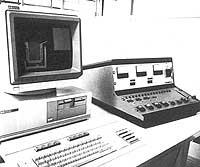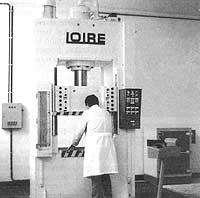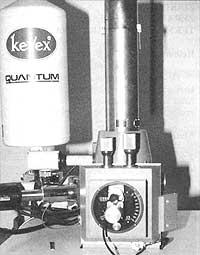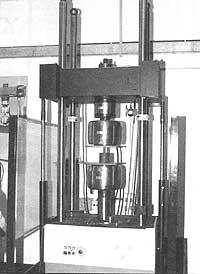INASMET: at the core of materials
Home

In 1962 the "Technical Association of Foundries of Gipuzkoa" arose, promoted by several Gipuzkoan companies. If INASMET was initially named as such, it was due to the need for quality control of products in foundries. Currently, quality control is carried out by each company, but from 1962 to 1970 INASMET played this role. Since 1970, several metallurgical engineers from the School of Industrial Engineers of San Sebastian joined INASMET. Thanks to their technical qualification, they began to offer technical assistance to companies. In addition to foundries, metallurgical companies benefited from INASMET services.
Therefore, in 1980 INASMET was formed by a team of 14 people and 100 partners or companies. Around that year and since the crisis affected the industry, INASMET suffered its most serious moments. However, this crisis affected the redefinition of INASMET, which caused research centers to have their place. In this situation, along with INASMET, were CEIT, Tekniker, Ikerlan and LABEIN. These five entities, together with the Basque Government, initiated a work plan for the future.

As a result of these works, the Basque Government created the figure of Protected Entity. Through this figure, the Basque Government has supported research centres for five years, that is, it carries out an annual economic allocation, but the centres do not lose their independence. It is the centres themselves that present the projects and the Basque Government oversees their work. This system encourages each center to different specialties. All this happened around 1982 and has continued to this day. On the other hand, the need for coordination of the different centers was seen and as a result the Association of Basque Technological Research Centers (EITE) was created in 1986.
Present
There are three types of participants in the INASMET Steering Committee: Industry, Basque Government and Provincial Council. Of course, the greatest specific weight corresponds to the industry. The participation of the Administration is oriented to the areas of advice and guidance.
Currently INASMET staff are distributed according to the following table:

Today the needs of local industries are the driving force behind INASMET, but also the field of research and new technologies. When you talk about the word research you want to leave aside basic research, since this is considered something proper of the university. INASMET wants to take advantage of this basic research to apply it to the productive processes, that is, for the industries to join these productive processes.
Financing and staff

The budget for 1988 amounts to 744 million pesetas. Of this amount, 437 million correspond to current expenses and the rest to investments and other expenses. As a Protected Entity, the Basque Government covers 40% of current expenses, that is, about 170 million euros. The same goes for the services provided.
What is missing to cover the budget practically leaves the Public Administration, both the Provincial Councils and the Basque Government and the European Economic Association. The amount extracted from these places is in exchange for training and project development courses. Participation in projects in Europe is increasingly important from a prestigious and economic point of view. Therefore, one of the objectives pursued in the coming years is to cover at least 10% of budgets in exchange for European projects.
Although the staff table has been set out in the previous section, these figures do not fully reflect the characteristics of the human team. It can be said that the people who were initially in INASMET were of pure vocation. Later people who worked in the industry were incorporated and in recent years many young people have entered. The latter are mainly dedicated to research. However, the workforce is very dynamic, that is, the human contribution from industry to INASMET is often transformed in reverse and this is rich for everyone.

On the other hand, given the growing importance of the curriculum, the publication and doctorate of the works are encouraged.
Future
The foreseen future is good. The grant extended from the Public Administration is consolidated and the industry is increasingly confident in the work of research centers. Therefore, industrial services will multiply in the coming years and the same will happen with projects developed throughout Europe in collaboration with other companies.
At the beginning of this article it is mentioned that the birth of INASMET was related to foundries. Most peninsular foundries, between approximately 70 and 80%, are located in the Basque Country, but INASMET has not achieved its approval. Therefore, for the coming years approval has become an objective.
We want to pay attention to the new areas, biotechnology, ADI and composites.
Biotechnology aims to analyze how to recover and recycle waste materials.

The technique called ADI is completely new and basically consists in providing the material with the desired properties of special thermal treatments performed in the processing of materials. At this time an agreement has been signed with several companies in the Basque Country so that the ADI technique can be applied to the needs of here.
Composite is not a new topic at INASMET. It works in both metal and organic matrix composites, and depending on the needs of the local industry, special attention must be paid to metal matrix composites. As is known, composite is a composite of ceramic material whose main properties are the obstruction of erosion.
Other areas are excluded from the mentioned areas. However, the majority mention can be seen elsewhere in this article.
Finally, we would like to thank all INASMET employees for their collaboration and facilities.
Association of Basque Technological CentresRITE EITE consists of five entities sponsored by the Basque Government, CEIT, IKERLAN, INASMET, LABEIN and TEKNIKER. Its objective is to present to the companies a joint offer of research and technological development. Among all the centers there are more than 500 scientists and engineers, but each retains its own activity and autonomy. Collaboration with the company can be of five types:
|
Ceramic coatings of projected plasma in diesel engines
Objectives

Ceramic coatings with anti-corrosion projected plasma and high temperature anti-wear on diesel engine parts.
Materials
- Oxides: Al2 O3, Cr2O3, Ti O2
- Carbides: WC, Ti C, Cr3C2
- Metals: Mo, Ni Al, Ni Cr, MCrAlY
Technologies
Thermal projection by plasma.
- Characterizations and essays.
- Optical microscopy.
- SEM.
- Microdeficiencies.
- Porosity.
- Erosion tests.
- Adhesion tests.
- Thermal shock.
INASMET work areas and equipment

Areas of action
- Casting Welding Steel Chemical Technology Lamination Polymers & Composites Forging Advanced Ceramics Thermal Treatments Surface Engineering
Studies and advice
- Advice on industrial processes. Failure analysis. Diagnosis of fractures produced at work. Corrosion studies and coatings. Analysis of Residual Life in boilers and ovens. Design advice. Pressure vessels. Advice on Technical Specifications. Testing of welding procedures Selection of materials. Use and optimization of processes.
- Industrial environment. Waste analysis. Special chemical processes.

Mechanical testing
- Tensile test (-70°C-1000°C). The elasticity limit is determined by extensometry. Cutting, crushing and bending tests. Resilience testing. Fracture mechanics tests.
- …
EQUIPMENT
- Closed softening serbohydraulic machines. Traction/compression machines. Calibrated equipment. Impact testing machine. Creep equipment
- …

Chemical analysis
- Analysis of metals and non-metals. Analysis of heavy metals. Gas measurement. Special analysis. Development of industrial analysis programs.
- Analysis of the constituents and solvents of the paints. Accelerated corrosion tests in saline mist percussion chamber. LPR tests (Determination of instant corrosion speed).
- ...
Techniques used
- Spectrophotometry Chromatography...
Thermal barrier development of zirconia ceramics
Objectives

Technological applications of thermal barriers in automotive parts and development of new techniques for obtaining thermal barriers inside parts of collectors and/or tents.
Materials
- Zirconia/Itria: Zr O 2 -Y 2 O 3
- Substrates: MCrAlY, NiCr, NiAl
Technology
Thermal projection by plasma.
- Characterizations and essays. Optical microscopy. SEM. Microdeficiencies. Porosity. Erosion tests. Adhesion tests. Thermal shock resistance tests.





